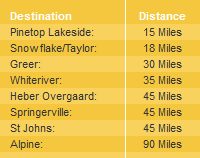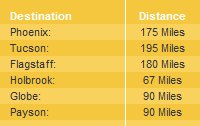




National 24-hour Domestic Violence Hotline - (800) 799-SAFE (7233) | (800) 787-3224 (TTY)
National Sexual Assault Hotline – RAINN - (800) 656-HOPE (4673)



West Fork of The Black River by flicker (CC BY-NC 2.0)
Basic Monsoon Information
Let's start off with some general information about monsoon season in northern Arizona:
The value of water across the American Southwest is well documented. Each monsoon season is viewed as a way to refill reservoirs and water supplies across the region. Forty to fifty percent of the annual precipitation falls during monsoon season. This is especially important to the many farmers and ranchers around northern Arizona who depend on this water to make a living.
Another aspect of monsoon season is the influence on the local fire weather season. The fire weather season in northern Arizona peaks near the end of June; as this is normally the warmest and driest period of the year. The beginning of the monsoon season continues the threat of fires as fire starts from dry lightning are common. However, after one to two weeks of widespread rainfall throughout early to mid July, the fire threat is greatly reduced during most years.
By Tony Subia
February 10, 2014
Most people do not expect Arizona to be like this. The landscape of the White Mountains of Arizona is very similar to that found in the Pacific Northwest or Canada. The Arizona White Mountains area of Northeast Arizona is mountain country. Thick forests of spruce, oak and aspen trees, Streams that meander through meadows of wildflowers bounding with wildlife.
The White Mountains is a four-season wonderland. Intoxicating beauty in all seasons. A beauty that feeds the adrenalin of the adventurous who thirst for the fresh aroma of the great outdoors. Emerging wildflowers come springtime. Cool summers that entice bikers, hikers and golfers. Golden colors of autumn that crescendo into cold winters covered with snow.
High elevation peaks rising to over 11,000 feet. Temperatures that average 25 to 35 degrees cooler than the desert regions to the south. A collection of mountain lakes in every direction offering fishing and camping areas. Hiking deep into wilderness areas. Even a ski resort that rivals many. All this just a three-hour drive from Phoenix and Scottsdale.
SHOW LOW — Years ago there was a television show some may recall called “The Life and Times of Grizzly Adams” and in it, one of the lovable characters constantly complained about the greenhorns.
A greenhorn is an untrained or inexperienced person or a newcomer. Only with time and experience does one graduate to the status of a local.
It is dry up here
One thing about mountain life no one expects is dry air. Be sure to keep plenty of water and moisturizer on hand and maybe even a bedside humidifier.
Leave no trace – Pack it in, pack it out – Prevent fires
Think about it. It would be highly offensive if someone were to walk though someone’s home and drop banana peels in the bathtub and trash the floors. The forest is home to many species of animals seen and unseen and they would appreciate a bit of consideration from their guests.
Fires need to be attended and completely extinguished. If something, anything, needs to be burned, a permit is mandatory.
Hummingbirds
Hummingbirds are one of the most rewarding things of mountain life. Like clockwork, they arrive in the spring and stay until their food source dries up. Bring the feeders in when the temperatures drop.
Regarding feeders — there is a right way to do that too — a fail-proof recipe. Take 1 cup sugar and add 4 cups of tap water (boiled to remove any impurities) and to help dissolve the sugar. Allow to cool and fill the feeder about a third of the way and seal the remaining sugar water in a jar and refrigerate for up to a week. Try to keep the feeder in a shaded area, if at all possible and replace the sugar water every two days to prevent sickening the birds with mold growth. And resist the urge to add red dye, as it is extremely harmful to them.
Mountain time is a real thing
Everything runs slower on mountain time. Everything.
The speed limits are lower for a reason. One never knows when an elk or a deer might step into the road and cause a wreck. Slow down.
Barbecue is a lifestyle
Better read up on the lingo, because it will come up in conversation. Even vegans grill up here.
Wildlife are not pets
Bears have learned that the presence of humans means food, so eliminate the risk an unpleasant encounter with the local bear by keeping trash sealed up until trash day. And it wouldn’t be a bad idea to carry bear repellent, especially at night.
Keep all trash inside a secured area until collection day. If that’s not possible, keep food waste in a bag in the freezer and place those in the trash as close to collection time as possible.
• If you’ll be out of town or are a weekend visitor, ask a neighbor to place your trash out on collection day.
• Take bird feeders down at night.
• Keep pet food inside or remove all uneaten food.
To report nuisance wildlife such as bears, call the nearest Arizona Game and Fish Department regional office during weekday business hours. The Pinetop Regional Office’s phone number is 928-367-4281.
Sunscreen
The need for sunscreen cannot be stressed enough. The sun’s rays are also closer, so be sure to always slather on the sunscreen when outdoors for more than a few minutes.
Four-season living
Some actually live here all year and contrary to what seems to be a common belief, they really do not appreciate strangers walking through their yards, sitting on their decks and eating their watermelon. True story!
Mountain living takes an adjustment, but it is worth the effort and greenhorns can become locals in no time.
